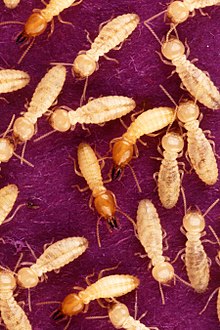Formosan subterranean termite
| Formosan subterranean termite | |
|---|---|
 |
|
| Scientific classification | |
| Kingdom: | Animalia |
| Phylum: | Arthropoda |
| Class: | Insecta |
| Order: | Blattodea |
| Infraorder: | Isoptera |
| Family: | Rhinotermitidae |
| Genus: | Coptotermes |
| Species: | C. formosanus |
| Binomial name | |
|
Coptotermes formosanus Shiraki, 1909 |
|
| Synonyms | |
|
|
The Formosan subterranean termite (Coptotermes formosanus) is an invasive species of termite. It has been transported worldwide from its native range in southern China to Formosa (Taiwan, where it gets its name) and Japan. In the 20th century, it became established in South Africa, Sri Lanka,Hawaii, and the continental United States.
The Formosan subterranean termite is often nicknamed the super-termite because of its destructive habits due to the large size of its colonies and its ability to consume wood at a rapid rate. A single colony may contain several million individuals (compared with several hundred thousand termites for other subterranean termite species) that forage up to 300 feet (100 m) in soil. A mature Formosan colony can consume as much as 13 ounces of wood a day (about 400 g) and can severely damage a structure in as little as three months. Because of its population size and foraging range, the presence of a colony poses serious threats to nearby structures. Once established, Formosan subterranean termites have never been eradicated from an area.
Formosan subterranean termites infest a wide variety of structures (including boats and high-rise condominiums) and can damage trees. In the United States, along with another species, Coptotermes gestroi, introduced from Southeast Asia, they are responsible for tremendous damage to property resulting in large treatment and repair costs.
The Formosan subterranean termite acquired its name because it was first described in Taiwan in the early 20th century, but C. formosanus is probably endemic to southern China. This destructive species was apparently transported to Japan prior to the 17th century and to Hawaii in the late 19th century. By the 1950s, it was reported in South Africa. During the 1960s, it was found in Texas, Louisiana, and South Carolina. In 1980, a well-established colony was thriving in a condominium in Hallandale Beach, Florida. Formosan termites are rarely found north of 35°N. They have been reported from 11 states, including Alabama, California, Florida, Georgia, Hawaii, Louisiana, Mississippi, North Carolina, South Carolina, Tennessee, and Texas. Their distribution will probably continue to be restricted to southern areas of the United States because the eggs will not hatch below about 20 °C (68 °F).
...
Wikipedia

